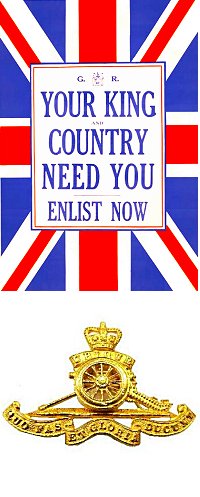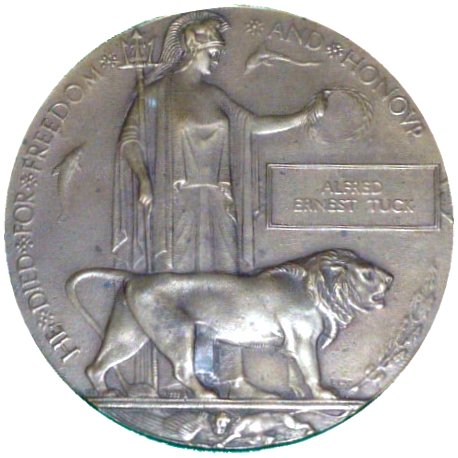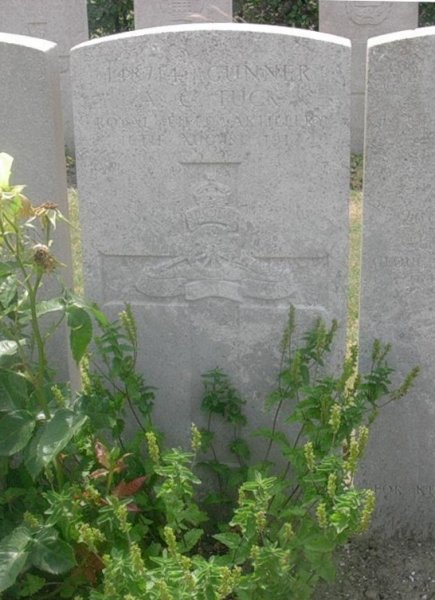yeovil at War
Alfred Charles Tuck
Died of wounds at the Battle of Langemarck
In truth Alfred Tuck spent very little time in Yeovil. He was born in 1895 in Speckington, Somerset, the son of farm carter John Tuck (b1871) originally from Clapton, Somerset, and Eliza Ann Bollen, known as Annie (1873-1956). John and Annie had seven children; Florence Lily (b1883, Bradford Abbas, Dorset), Alfred Charles, Arthur (b1898, Aldon), Dorothy Maud (b1900, Bradford Abbas), Edwin Frank (1902, Over Compton-1979), William Wilfred (1904, Rowlands Farm, Devon-1985) and Ethel Evelyn (b1908, East Coker).
As seen by the birthplaces of the children, the family seemed to move around from farm to farm and in the 1901 census John, Annie and their four eldest children were listed at Over Compton, Dorset. John was still listed as a 'Carter on Farm' while Alfred was a 'Carter boy on Farm'.
 Alfred
enlisted in
Yeovil although
it is not known
when. He joined
the Royal Field
Artillery,
Service Number
148714, and was
in 'D'
(Howitzer)
Battery, 71st
Brigade.
Alfred
enlisted in
Yeovil although
it is not known
when. He joined
the Royal Field
Artillery,
Service Number
148714, and was
in 'D'
(Howitzer)
Battery, 71st
Brigade.
This brigade was originally comprised of numbers 223, 224 and 225 Batteries RFA and the Brigade Ammunition Column. It was placed under command of the 15th (Scottish) Division and moved to France with it in July 1915. The brigade remained with 15th (Scottish) Division throughout the war. On 7 June 1916 D Battery left to join 73 (Howitzer) Brigade of the same division, and became that brigade's C Battery. It was replaced in 71 Brigade by C Battery from 73 (Howitzer) Brigade, which now became 71 Brigade's 'D' (Howitzer) Battery. It is likely that it was around this time Alfred enlisted. On 22 January 1917 a section of two howitzers from 532 (Howitzer) Battery of 72 Brigade joined and was added to D (Howitzer) Battery.
In 1917 'D' Battery, including Alfred, was in action at the First Battle of the Scarpe (9 to 14 April 1917) which was part of the Arras Offensive.
Zero-Hour for the First Battle of the Scarpe had originally been planned for the morning of 8 April (Easter Sunday) but it was postponed 24 hours at the request of the French, despite reasonably good weather in the assault sector. Zero-Day was rescheduled for 9 April with Zero-Hour at 05:30. The assault was preceded by a hurricane bombardment lasting five minutes, following a relatively quiet night. When the time came, it was snowing heavily; Allied troops advancing across no man's land were hindered by large drifts. It was still dark and visibility on the battlefield was very poor. A westerly wind was at the Allied soldiers' backs blowing "a squall of sleet and snow into the faces of the Germans". The combination of the unusual bombardment and poor visibility meant many German troops were caught unawares and taken prisoner, still half-dressed, clambering out of the deep dug-outs of the first two lines of trenches. Others were captured without their boots, trying to escape but stuck in the knee-deep mud of the communication trenches. Most of the British objectives had been achieved by the evening of 10 April though the Germans were still in control of large sections of the trenches between Wancourt and Feuchy.
This action was followed a week later by the Second Battle of the Scarpe (23 to 24 April 1917). On 23 April, the British launched an assault east from Wancourt towards Vis-en-Artois. The British made initial gains but could advance no further east and suffered heavy losses. Farther north, German forces counter-attacked in an attempt to recapture Monchy-le-Preux, but British commanders determined not to push forward in the face of stiff German resistance, and the attack was called off the following day on 24 April.
The Brigade than moved north to Flanders where it again saw action during the Battle of Pilckem, part of the Battle of Passchendaele.
The Battle of Pilckem Ridge, 31 July – 2 August 1917, was the opening attack of the Third Battle of Ypres. The British Fifth Army, Second Army and the French First Army on the northern flank, attacked the German 4th Army which defended the Western Front from Lille, to the Ypres Salient in Belgium and on to the North Sea coast. On 31 July, the Anglo-French armies captured Pilckem Ridge and areas either side, the French attack being a great success. After several weeks of changeable weather, heavy rain fell during the afternoon of 31 July. British observers in the XIX Corps area in the centre, lost sight of the troops that had advanced to the main objective at the green line and three reserve brigades pressing on towards the red line. The weather changed just as German regiments from specialist counter-attack Eingreif divisions intervened. The reserve brigades were forced back through the green line to the intermediate black line, which the British artillery-observers could still see and the German counter-attack was stopped by massed artillery and small-arms fire.
The attack had mixed results; a substantial amount of ground was captured by the British and French, except on the Gheluvelt Plateau on the right flank, where only the blue line (first objective) and part of the black line (second objective) were captured. A large number of casualties were inflicted on the German defenders, 5,626 German prisoners were taken and the German Eingreif divisions managed to recapture some ground from the Ypres–Roulers railway, northwards to St Julien. For the next few days, both sides made local attacks to improve their positions, much hampered by the wet weather. The rains had a serious effect on operations in August, causing more problems for the British and French, who were advancing into the area devastated by artillery fire and partly flooded by the unseasonable rain.
Two weeks later Alfred saw his last action in the war, the Battle of Langemarck.
The Battle of Langemarck from 16–18 August 1917, in which 'D' Battery, 71st Brigade - including Alfred Tuck - took part, was the second Allied general attack of the Third Battle of Ypres. The battle took place near Ypres in Belgian Flanders on the Western Front. The Allied attack succeeded in the north, from Langemarck to Drie Grachten ("Three Canals") but early advances in the south on the Gheluvelt Plateau were forced back by powerful German counter-attacks. Both sides were hampered by rain, which had a greater effect on the British who occupied lower-lying areas and advanced onto ground which had been frequently and severely bombarded.
Alfred was mortally wounded on the first day of the battle, 16 August 1917, and died from his wounds. He was 22 years of age and was interred at Brandhoek New Military Cemetery No 3, West-Vlaanderen, Belgium, Grave II.B.11.
In its edition of 31 August 1917 the Western Gazette reported "Mr and Mrs John Tuck, of 26 Cromwell Road, Yeovil, have received official information that their eldest son, Gunner AC Tuck, of the Royal Field Artillery, has been killed in action in France."
Alfred Tuck's name is recorded on the War Memorial in the Borough.
Other Yeovil
lads killed on
this day include
-
Albert Burgess,
Harold Dicks,
Robert Fry
and
Frederick Hunt.
gallery

The Memorial Plaque commemorating Alfred Tuck. Also known as Death Plaques, the plaques were made of bronze, and hence popularly known as the "Dead Man’s Penny", because of the similarity in appearance to the somewhat smaller penny coin. Diameter approx. 120mm, rim thickness approx. 4mm, weight approx. 333g. 1,355,000 plaques were issued, which used a total of 450 tons of bronze. They continued to be issued into the 1930s to commemorate people who died as a consequence of the war.

The Commonwealth War Graves Commission certificate commemorating Alfred Tuck.

Alfred Tuck's headstone at Brandhoek New Military Cemetery No 3, West-Vlaanderen, Belgium.